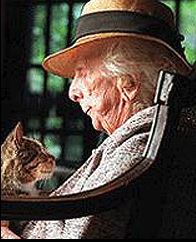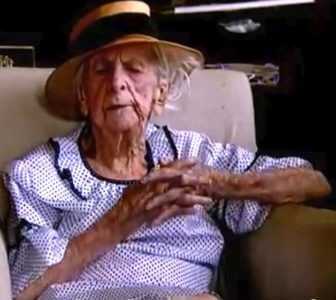TWH – Marjory Stoneman Douglas became a household name once again after the violence at the High School bearing her name. This week, that school was in the news again when deputy, Scot Peterson was charged with negligence for his alleged failure to take action to protect the students and teachers during the school shooting.
Long before that tragedy, Marjory Stoneman Douglas was a household name in South Florida as an environmentalist. Douglas was a force of Nature, now affectionately called “Mother of the Everglades.” She was not a Pagan, but her life’s work is like a Pagan call to defend the Earth.
Douglas’ defense of nature was legendary. At 103 years old, the writer, journalist and environmentalist was presented with the National Medal of Freedom in 1993 by then President Bill Clinton who commented, “the next time I hear someone mention the timeless wonders and powers of Mother Nature, I’ll be thinking about you.”

Friends of the Everglades [CC BY-SA 3.0 (http://creativecommons.org/licenses/by-sa/3.0/)]
Marjory Stoneman Douglass [Credit: Friends of the Everglades]
Early life and career
Douglas had a rough early life. A disastrous, but brief, marriage followed an unstable family life during childhood.
After the breakup of her family-of-origin, her father, Frank Stoneman, moved to Florida. He started The Miami Herald, now the major daily newspaper in Miami. In 1915, Douglas moved to Miami to join him and get away from her husband. Soon, she obtained a divorce.
During WWI, Douglas had a brief stint in the Naval Reserve. She was the first woman from Florida to join that body. After that, she worked with the American Red Cross in Paris to care for the wounded. When the American Red Cross left Paris, her father offered Douglas a job as assistant editor at the Herald.
In the 1920s, Douglas wrote a column for the Herald. She wrote about poverty, women in leadership, and the ecology of South Florida. Douglas quit the Herald in 1923 to become a freelance writer. The Saturday Evening Post published 38 of her stories.
Her work with the Everglades
Her first direct involvement with the Everglades took place in the 1920s. She joined the board of the Everglades Tropical National Park Committee. That group had the goal of creating the Everglades National Park. In 1934, Congress created the Everglades National Park. But purchasing the land took much longer. The Everglades National Park finally opened to the public in 1947.
While researching ideas for a book about the Miami River, her interest in the Everglades grew. That interest began to overshadow her interest in the Miami River. In 1947, Douglas published her best known book, “The Everglades: River of Grass.“ A transformational work on how to understand the ecosystem just west of Miami. She revised it in 1987 to include material about new threats.
In South Florida, “River of Grass” ranks in impact with that of Rachel Carson’s “Silent Spring.”
Douglas described the Everglades as stretching, “in one thick enormous curving river of grass, to the very end.” She changed the way people understood the Everglades. Douglas promoted the idea that Everglades was a very slow moving river. Sometimes, that river had a depth of just one inch (2.54 CM). Sometimes that river had a breadth of 50 miles (80.47 KM). But it was a river nonetheless.
This slow river nourishes marshes, mangroves, and forests of pine and palms. Twenty-one endangered species live in or along it. Before her, many people thought of the Everglades as a worthless swamp. Some still do, but she changed minds.
She was actually carrying on a family tradition. Her father, Frank Stoneman, had opposed the plans of Florida’s then Governor Napoleon Bonaparte Broward. That governor wanted to drain the Everglades. The two became enemies.
At the age of 79, she founded Friends of the Everglades to stop the creation of a jetport in the Everglades. That jetport was planned to be larger than the JFK airport. Her efforts along with those of others forced Nixon to cancel that project.
She would persist in her defense of the Everglades until her death. Unflappable in the face of opposition she consistently stood her ground. When a coalition of corporate interest insisted that 240 square miles (622 sq km) of the Everglades should be drained, Douglas put on her famous straw hat, white gloves, and string of pearls then went to the coalition demonstration. They wanted local politicians to allow the draining. She delivered her speech to the jeering crowd. As she did, she looked straight into the angry group of corporate developers and farmers and said that because she was almost deaf, they would have to “boo louder.”
Personal life
She never remarried after her divorce in 1917 and never partnered again. Later in life, Douglas said that if you are in love with a man, “you are unconsciously dependent on him.” She never owned a car or even learned to drive, which, in South Florida, counts as a major achievement. Raised an Episcopalian, as an adult Douglas identified as an agnostic. She stipulated that, after her death, no religious service should occur.
Even though Douglas gained fame for her writings about the Everglades, she did not spend much time there. She described the Everglades as “too buggy, too wet, too generally inhospitable.” Her love for the Everglades brought her to respect its privacy and independence. The presence of humans seldom benefits wilderness areas.
Other politics and social justice issues
While attending Wellesley College, Douglas was active in its women’s suffrage groups. Along with four other women she testified in favor of women suffrage before the Florida Legislature in 1916. That body failed to impress her.
Since the 1920s, Douglas lived in Coconut Grove. At that time, the Grove was racially segregated. Homes in the Black areas lacked indoor toilets and running water. They had no connections to sewer lines. Douglas worked to require that all homes have running water, indoor toilets, and connections to sewers. She also set up a loan program for low-income residents. That program provided interest free loans to pay for the necessary plumbing expenses.
Douglas in pop culture
Before the massacre, Douglas had become enough of an icon to make her way into pop culture. She became a character in an online video game, “A Golden Wake.” That game is based on Florida’s land boom of the 1920s.
An episode of “The Simpsons,” referenced Douglas. In “Bart vs. Thanksgiving” (Season 2, episode 20), Lisa Simpson made papier-mâché busts of Douglas, Georgia O’Keefe, and Susan B. Anthony. Those busts formed a centerpiece for the Simpson’s Thanksgiving dinner. Lisa wanted to thank these three women. Of course, being the highly dysfunctional Simpson family, things did not go according to plan.

(https://creativecommons.org/licenses/by-sa/3.0)]
Majory Stoneman Douglass [Credit: Abigail B Wright of Miranda Productions, Inc.]
In her personal spirituality, Douglas was an atheist. She would later write in her autobiography,
The soul is a fiction of mankind, because mankind hates the idea of death. It wants to think that something goes on after,” she wrote. “I don’t think that it does, and I don’t think we have souls. I think death is the end. A lot of people can’t bear that idea, but I find it a little restful, really.
I believe that life should be lived so vividly and so intensely that thoughts of another life, or of a longer life, are not necessary.
The Everglades would become not just a National Park but a World Heritage Site, an International Biosphere Reserve, a Wetland of International Importance, and a specially protected area under the Cartagena Treaty. Everglades contains the largest mangrove ecosystem in the Western Hemisphere and the most important breeding ground for tropical wading birds in North America.
This week a long-hoped for restoration project of the Everglades received final approval for funding and implementation. Governor Ron DeSantis announced in a tweet that a $100 million project to create a nearly 7-mile bridge to restore the natural flow of water in the Everglades and ultimately to Florida Bay was approved.
It is the result of years of effort at the State and Federal level that included politics and pestering against power. They fulfill Douglas’ advice: “Be a nuisance where it counts, but don’t be a bore at any time.”
The Wild Hunt is not responsible for links to external content.
To join a conversation on this post:
Visit our The Wild Hunt subreddit! Point your favorite browser to https://www.reddit.com/r/The_Wild_Hunt_News/, then click “JOIN”. Make sure to click the bell, too, to be notified of new articles posted to our subreddit.